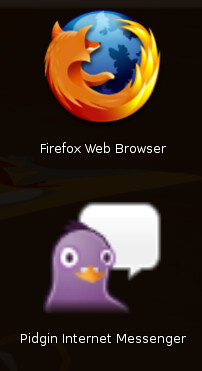I've been testing some software recently that includes liberal use of large program icons in Ubuntu. Historically, Debian packages have used XPM for icons, because they diff easily and are compressed already via packaging. More recently, vector graphics have become popular in many places in the desktop and the web with today's bigger and higher DPI computer displays, because vector graphics are resolution independent. This makes for neat stuff, like quick launchers and desktop icons that scale cleanly with size:
SVGs are nice, but there's still a few reasons you might still use PNG. They're far more plentiful -- even I'm guilty of converting a Windows .ico into a PNG for an icon. And they take less disk space, since SVG is a verbose XML, while PNG is a compressed format. But when size really counts, it also possible to compress SVG with gzip.
But times are changing. Linux, and Ubuntu in particular, is moving into several different devices with different resolutions, aspect ratios and display sizes. Lots of technology is needed to cope with the diversity, as Shuttleworth noted (33:30 timestamp). SVG plays a role in coping resolution and size. This screencap demonstrates how stark the difference is on my laptop:

So what's holding widespread SVG on Ubuntu back? Disk space is a minor concern on the most constrained devices that Ubuntu could run on, but I think that's a wash when you start storing 5 sizes of icons versus one scalable graphic. Render time is an interesting question that depends on a host of factors. If we assume standard icon bitmap sizes, I would imagine it's a win for PNG. If we remove that restriction, you have to throw in the cost of scaling the PNG. Bryce Harrington, Ubuntu X developer and Inkscape founder, offered the following insight:
< bryce> svg supports advanced functionality like filters, gradients, etc. which can be processor intensive for some chipsets
< bryce> however a really trivial one - just some simple shapes of solid colors - could actually render faster
< bryce> filesystem I/O tends to be a major performance killer, so any optimization which allows you to avoid file I/O at the expense of processor or memory, tends to work out pretty well
Bryce went on to suggest that tricks to rescale both PNG and SVG by raster lines were occasionally used in performance sensitive code. Gzip compressed SVG might help under specific situations, since it reduces I/O and you can pipeline some of it. But we're talking peanuts for icons, since most will fit within a single small contiguous extent.
The most interesting argument I saw was from Johan Brannlund:
< johanbr> Bitmap icons tailored for small sizes look better than SVG.
There's no easy way to dispute that. I don't think you'll find superb pixel art coming out of SVG renders. I'm not sure it matters, but it helps. One thing that can be done is see how many packages are actually customizing their tiny PNG icons. Firefox seems to. Deluge might, I can't really tell the difference between their PNG and the SVG. Pidgin is actually backwards here -- as far as I can tell, they generate SVG from PNG, yielding the worst of all worlds. Carrier (aka "funpidgin" aka "that silly fork of pidgin") does the same. So clearly all three practices are in use; it would be interesting to see how common each practice is (and document new ones), but I'm not sure there's a good way to do it. So if you see me filing bugs and tags in the next few weeks, this is what's up.
Comments !